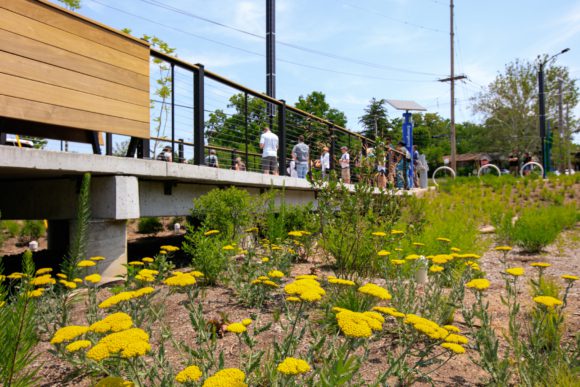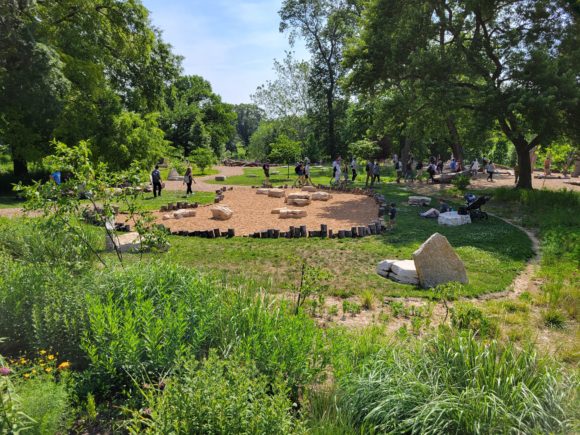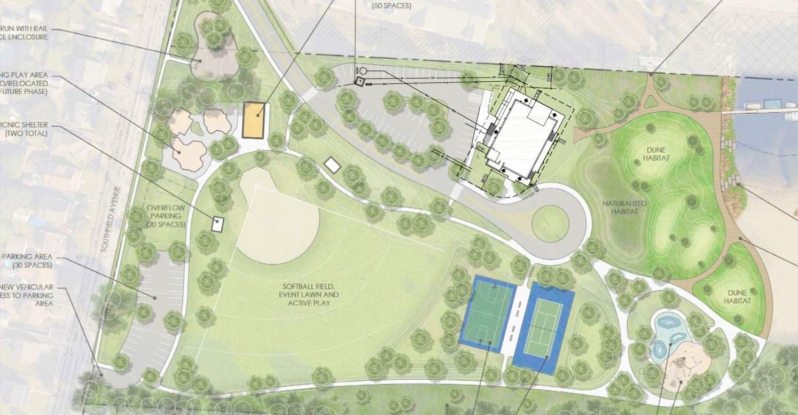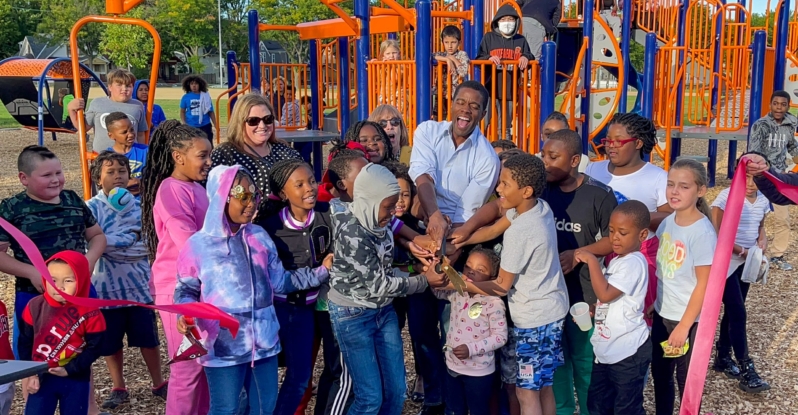The power of parks as restorative infrastructure was fully evident during City Parks Alliance’s park study tour in St. Louis, MO, June 1 – 3. Thirty-five participants from 14 states and Canada joined us for an immersion in the history of this manufacturing-legacy city, revealed through the changing design of its built and natural environment, the collective memory of its residents, and the relationships among public agencies, non-profit and institutional partners, indigenous tribes, and community-based organizations.
A Shrinking City Full of Possibility
Founded along the Mississippi River on the territory of a confederacy of Native American tribes who were eventually driven away from the region by European settlers, St. Louis became the starting point for the western expansion of the U.S. in the early 1800s. A wave of European immigration boosted the city to the rank of the country’s fourth largest by the late 1800s, and the Great Migration contributed to a population of 856,000 by 1950. The city’s industrial might and civic largesse left a legacy of remarkable large-scale parks set in the geographical quadrants—Forest Park, Tower Grove Park, Fairground Park, and Gateway Arch National Park, added in the 1960s—along with vibrant cultural and academic institutions, and a rich architectural heritage.
St. Louis’ more recent history reflects the post-industrial trajectory. The city experienced a slow decline in population beginning in the mid-1950s as manufacturing jobs decreased, people migrated to the suburbs, and efforts to revitalize the urban core led to the displacement of existing residents. Adjacent to St. Louis, the Ferguson protests against the killing of a Black teenager by a policeman in 2014 underscored racial tensions and historical inequities. Today local leaders are planning for a smaller city with a population one-third of its peak. Despite the ongoing presence of physical and psychological divides–driven by a combination of failed urban revitalization planning, macro-economic shifts, and racial segregation (through intentional and implicit policies), greenways and parks are beginning to create a new system of interconnected neighborhoods, adding needed green spaces and amenities, and inspiring a more honest narrative about St. Louis’ past and a more hopeful one about its future.

St. Vincent Greenway, part of the St. Louis’ Great Rivers Greenway.
New Linkages and Accessibility
Great Rivers Greenway (GRG) is a public agency created in 2000 through a publicly endorsed sales tax dedicated to parks and greenways. GRG oversees a connected system of 135 miles of greenways and counting, working in partnership with 100+ municipalities and institutions, and aims to create a 600-mile network of greenways connecting St. Louis City with the surrounding counties and linking neighborhoods within the city, anchored by the four signature parks.
The St. Vincent Greenway has recently been extended over a culvert as part of a stormwater management plan at the Engelholm Creek Overlook. This leg of thetrail network connects to a job training center, a small business incubator, and a light rail stop. At City Foundry, a multi-use center built on a former manufacturing hub, the next leg of the Brickline Greenway will provide a new link to shopping, entertainment, restaurants, and creative workspaces.
The Mississippi Greenway passes along the city’s iconic Gateway Arch National Park, which has undergone significant changes to increase accessibility. A highway that once separated the park from the downtown has been capped to create a continuum from the Mississippi River and park site to the Old Courthouse, where the Dred Scott decision was made. The new Visitor Center is also now more available to people with a range of disabilities, thanks to the advocacy of David Newburger, St. Louis Commissioner on the Disabled, and a citizen-led Universal Design Group, who provided input on the exterior and interior design, including tactile exhibits to show the scale of the Arch for the sight impaired. A few years ago, the name of the park itself was changed to provide a more inclusive recognition of American history.
More residents will be able to enjoy the city’s largest park through a partnership between the City of St. Louis Department of Parks, Recreation and Forestry and their non-profit partner Forest Park Forever that is adding basketball courts to Forest Park for the first time. This 1,300-acre park is the site of the 1904 World’s Fair and Summer Olympics, and in 2023 Forest Park was named the Best City Park in the Nation in the annual USA Today Readers Survey. There has been a growing desire in the St. Louis community to add basketball to the amenities of Forest Park, and to better understand what would make these new courts most successful, Forest Park Forever commissioned a survey of the broader community. This survey included both current Forest Park users and people who enjoy basketball, but do not currently come to Forest Park. The feedback received included comments on the style of play people wanted to see in the park, various amenities, and even the desired court surface. Respondents also noted their interest in active programming to intentionally invite the community to use the new courts. The CPA and RAND National Study of Neighborhood Parks, which included St. Louis, also prompted the park groups to provide more programming for teen girls.
New Narratives
Park organizations are exploring the city’s history in partnership with long-time residents to uncover hidden stories and share them in the public realm. During a panel discussion on Community Engagement and Public Art, Great Rivers Greenway’s Shaughnessy Daniels, Director of Civic Engagement, and Anna Leavy, Brickline Greenway Program, shared aspirations for and examples of cultural programming along the greenway’s extensive bike and pedestrian network. They described how art and design can address trauma, celebrate cultural identity, and support a healthier future for all by “unearthing, provoking, connecting, cultivating, healing, and envisioning.”
Pillars of the Valley is a public art installation by East St. Louis native Damon Davis created as a tribute to Mill Creek Valley, a once thriving Black neighborhood that was demolished in the 1960s under the guise of “urban renewal.” Positioned in a plaza at the entrance to a new soccer stadium and along the Brickline Greenway, the project captures the recollections of former residents and preserves the footprints of homes in the neighborhood, embedding traces of the past and creating an ongoing forum for public dialogue at this downtown site.
At the Victorian-era Tower Grove Park, a National Historic Landmark, we heard about the multi-stakeholder Columbus Statue Commission, created in 2018 in response to calls for the removal of the park’s 130-year-old Christopher Columbus statue. The commission recommended keeping the statue but enhancing education and commemoration of regional Native American history (the statue was ultimately removed due to safety concerns after similar statues were torn down by protesters in response to the murder of George Floyd). Among the commission were members of the Osage Nation, who are now partnering with the Park to share their history and culture through educational and artistic opportunities connected to a “daylighted” stream that had been buried for a century. Named Nee Kee Nee, or “revived water” in Osage, it is the centerpiece of a flood control project designed by Lamar Johnson Collaborative that has not onlyrestored the water flow and managed it better during storm events, but also created a water-based natural playspace for children.

Natural play space in St. Louis’ Forest Park
In the city of Wellston, just beyond the St. Louis border at Trojan Park (a project supported by the National Recreation and Park Association), we heard fromMayor Nathaniel Griffin about the significance of the park’s name as a way to honor the memory of the local high school’s sports team through the vibrancy of the park itself. The school was shuttered years ago in a community with high levels of vacancies but the pride of the Trojan spirit lives on in a beloved local park that has become an intergenerational community hub. “Parks bring people and families together. This is one of the best things that has happened to the community,” said Mayor Griffin in his remarks to the group.
This recent park study tour was City Parks Alliance’s seventh one. Each has highlighted the uniqueness of the setting—the history, geography, political dynamics, economic conditions, and the people–and how nature-based approaches are reconfiguring the way cities work and how residents relate to each other. In St. Louis, we were inspired to learn about a city facing the challenge to create a more equitable and resilient future, with parks, greenways, and outdoor recreation driving that change.

Group photo of the St. Louis Park Study Tour participants.
We thank our local host partners Gateway Arch Park Foundation, Forest Park Forever, Great Rivers Greenway, Tower Grove Park, and Explore St. Louis for their many contributions to the program and the Crawford Taylor Family Foundation and Agency Landscape + Planning for their generous support.
Learn more about the St. Louis Park Study Tour, including photos, audio, and more.




